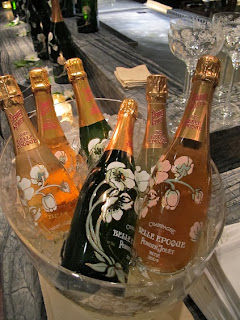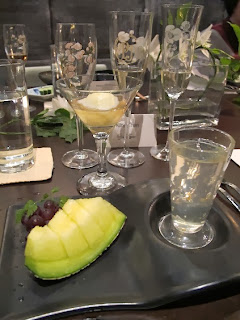Underneath the layers of opulence and luxury of superior Champagne lies an need foa balance between the finest natural ingredients and expert knowledge. Perrier-Jouët's 7th Cellar Master in two centuries, Hervé Deschamps born into a family from the Champagne region has the know-how of the art of blending the various Champagne wines while retaining the hallmark charm and elegance of Perrier-Jouët’s cuvées. Deschamps talks to mylifestylenews over a <Taste of Belle Epoque> pairing lunch at Inagiku prepared by Executive Chef Shigeru Tangigawa......
I was born in 1956 into a family from the Champagne region and I studied agriculture and oenology at Dijon and went on to earn degrees in both agronomy and oenology.
I completed my studies with work on nutrition and food sciences before joining Perrier-Jouët
in 1983 as oenologist in charge of the fermentation process and the cellar ageing of wines. I was soon appointed as assistant to Cellar Master André Bavaret, the guardian of the Perrier-Jouët house style for almost 30 years.
During that time, I learned much about the art of blending the various Champagne wines while retaining the hallmark charm and elegance of Perrier-Jouët’s cuvées.
In 1993, I succeeded André to become only the seventh Cellar Master in Perrier-Jouët’s two-hundred-year history. Since then I have been in charge of producing the entire Perrier-Jouët range, including Grand Brut (vintage and non-vintage), Blason Rosé and the legendary Belle Epoque and Belle Epoque Rosé cuvées.
I went straight to the blending stage, rather like an artist, trusting in an inexplicable fusion of intuition, sensitivity and skill. Emile Gallé, the master glassmaker of the Art Nouveau movement who created the anemone design on the Belle Epoque bottle in 1902, would doubtless approve.
The Perrier family already has a long history of cultivating vine yards to draw from and benefited from owning land in the best areas of Champagne region including some of the grand Crus and the vineyards of Montagne de Reims and Cote Du Blancs commonly knows as the "Champs Elysees of Champagne".
Today, Perrier-Jouët expresses fine champagne as an art form not only in the produce by also the bottle, every Belle Epoque bottle is decorated with flower patterns designed by Ecole de Nancy, a leading artist from the At Noveau movement.
The <Perrier-Jouët Grand Brut> is build on the structure and depths of the Pinot Nior grape from the Premiers and grand Crus of Mailly, Verzy, Ay and Rilly la Montagne.
The delicate flavaour brings out the appealling, rounded fruit style of Pinoty Meunier. Light yellow in colour, its vibrancy in the glass suggests refreshment and the aroma is defined by notes of perfume and spice.
The taste is smooth and harmonious with plenty of character, lending the wine charm and elegance that are Perrier-Jouët hallmark.
The <Blason Rose cuvee> contains the highest proportion of Pinot grapes in the company range, comprising almost 75% Pinot, half of which is Pinot Noir.
This is a rich cuvee; rose in colour with a light orange tint, with a lifted bouquet aroma dominated by ripe red fruits, such as raspberry and wild strawberry.
Full, textured and rich in mouth, the wine delivers structure and substance, yet with a pleasant freshness.
<Perrier-Jouët Belle Epoque> is aesthetics and pleasure combined in classic cuvee, this is the hallmark Champagne of the house. The epitome of pleasure, Perrier-Jouët's Belle Epoque is the product of a two-hundred-year old house and its superlative vineyard.
The wine has a light yellow shade tinged with vibrant green, given the presence of Chardonnay. The nose opens with white flower aromas, moving to reveal honeyed notes and biscuity, brioche finish.
The Pinot Noir influence lends masking its suppleness, preserving the cuvee appealing lightness, This is a delicate wine with discernable charm, and long, soft finish.
<Perrier-Jouët Belle Epoque Rose> is a rare cuvee, first and foremost the expression of a delicate, elegant wine style, inspired by two centuries of winemaking heritage.
The year 2002 yielded some superb Chardonnays, distinctive and concentrated, full of freshness, depth and maturity. These are ripe, luxuriant wines that retain their lightness, structure and long finish. This is a Champagne of great finesse with good potential for ageing.
There's a dash of seductive charm in addition to Belle Epoque's customary elegance.
<Perrier-Jouët Belle Epoque Blanc de Blancs> is the rarest champagne of the House. This stems from the fruit of a single vineyard, a single grape variety, a single year. Only two plots are used in the blend, and only during the most exceptional years.
This leads to a very limited production which is sought after by connoisseurs and collections alike.
The selected plots of Champagne nestle in the heart of the most famous Champagne grands Crus, the village of Cramant, considered to be the purist expression of Champagne chalk soil.
In the mouth, the wine is initially unabashed, upright and lively. This is followed by more feminine and sensual impressions full of finesses and elegance, and the taste finishes with a roundness and charm which ensure a long and persistent memory.
<Fresh Tomato stuffed with Sesame bean Curd served with White asparagus & Caviar>
paired with Perrier-Jouët Belle Epoque Blanc de Blancs
<Pink Somen Noodle with Hot Spring Egg Yolk>
&
<Snapper marinated in Konbu Kelp served with Sake & Plum Sauce>
paired with Perrier-Jouët Cuvee Belle Epoque Blanc 2004
<Simmered Sakura Shrimp with Lily Root Beancurd>
&
<Japanese Wagyu Beef Steak>
paired with Perrier-Jouët Cuvee Belle Epoque Rose 2004
<Kama Steamed Rice with Sakura Shrimp>
&
<Champagne Yuzu Sherbet served Japanese Melon>
paired with Perrier-Jouët Cuvee Belle Epoque Rose 2004
mylifestylenews in conversation @ Hervé Deschamps





















No comments:
Post a Comment